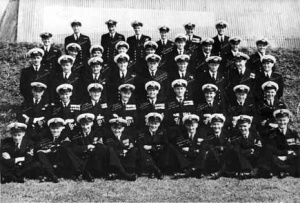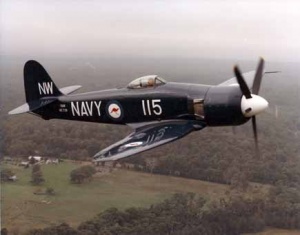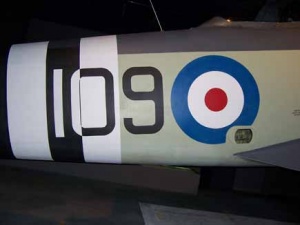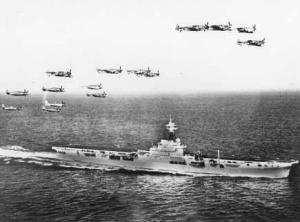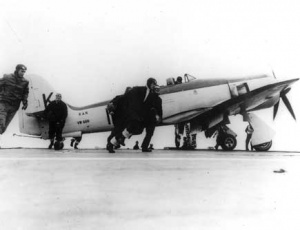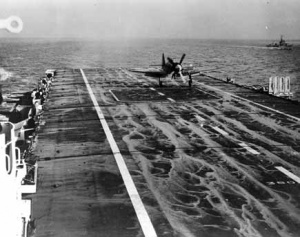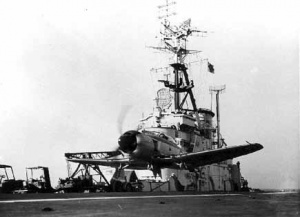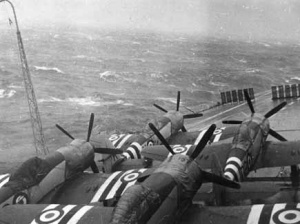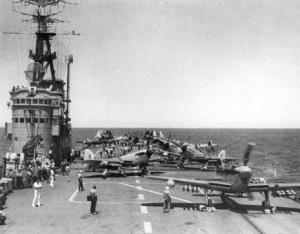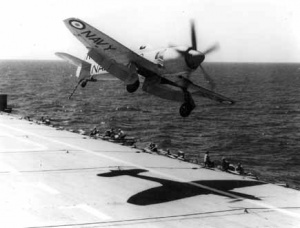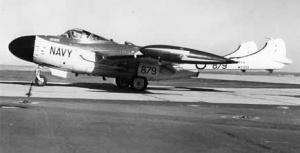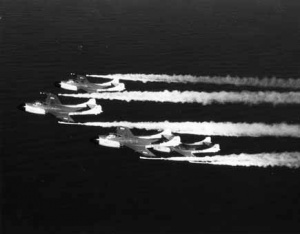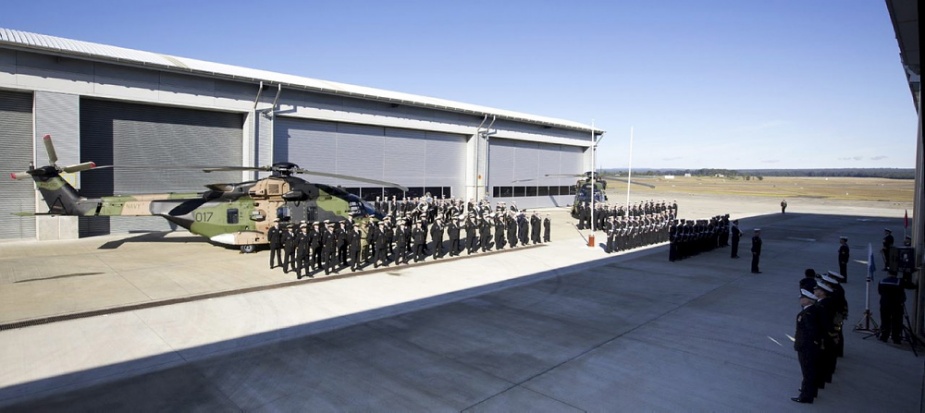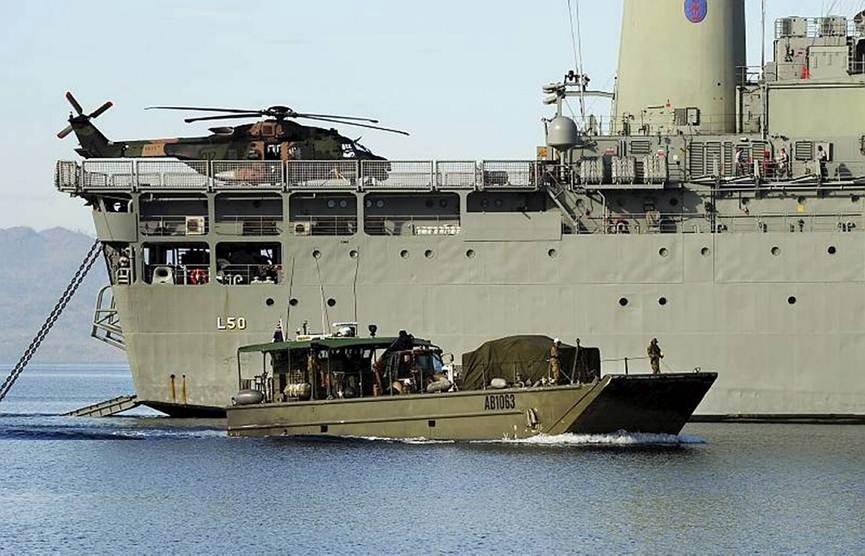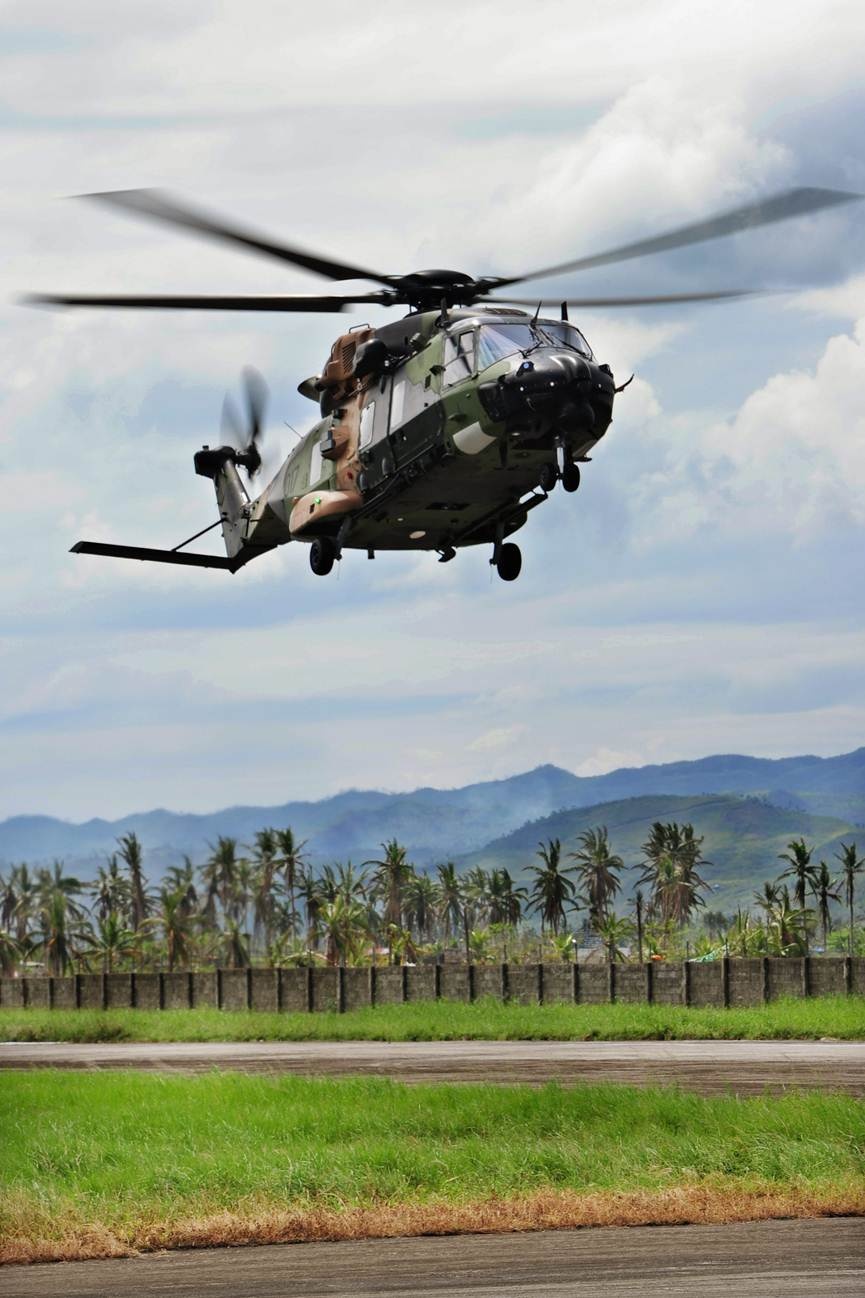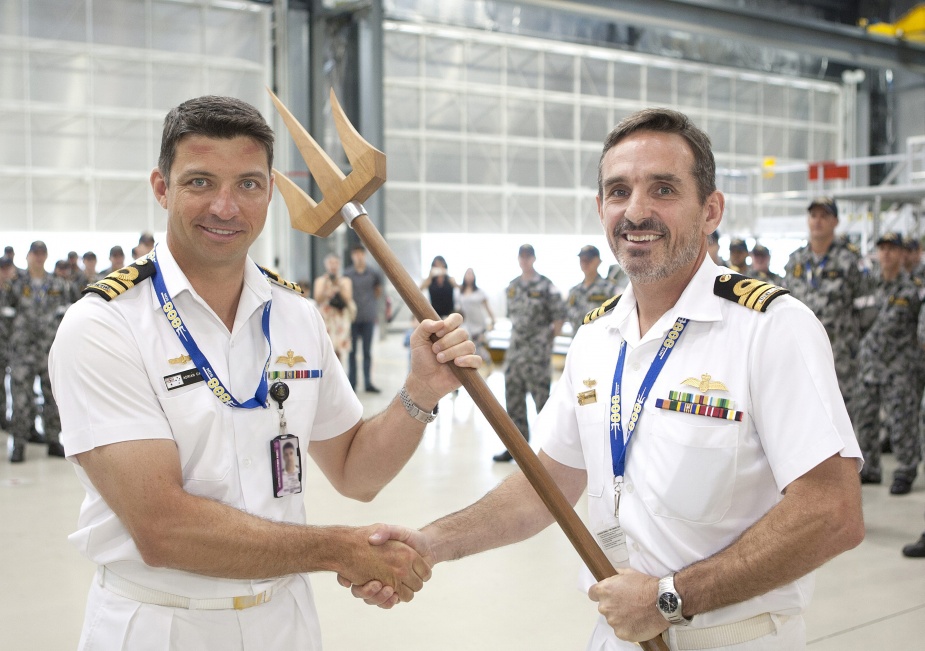808 Squadron History
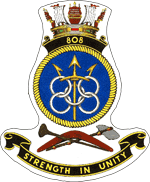
808 Squadron has its origins in the Royal Navy where it was formed as a fleet fighter squadron in June 1940, before being merged with 807 Squadron in November 1941. It was one of just two Royal Navy Fleet Air Arm squadrons to participate in the Battle of Britain (along with 804 Squadron) and was also involved in the D-Day landings of May/June 1944. It was redeployed to the East Indies Fleet before being disbanded at the end of World War II. For a time at the end of 1940 and beginning of 1941, the Squadron's Senior Observer was a young Australian on loan to the Royal Navy. Lieutenant (later Admiral Sir) Victor Smith would go on to play a central role in the establishment of an Australian naval aviation wing and would become known as the 'Father of the Fleet Air Arm.'
808 Squadron was recommissioned as a RAN squadron on 25 April 1950, Anzac Day, at St Merryn in Cornwall, England with Lieutenant Commander John Appleby, RN, in command. Flying Hawker Sea Fury FB IIs, 808 Squadron formed part of the 21st Carrier Air Group (CAG) along with 817 Squadron. The CAG embarked in the RAN's new aircraft carrier, HMAS Sydney in October, with now Commander Victor Smith the ship's Executive Officer, and disembarked at Jervis Bay in December.
21st CAG began carrier qualifications aboard Sydney in April 1951 and would tragically suffer its first fatal accident the following month. On 3 May 1951, Lieutenant Bob Barnett of 808 Squadron was killed when he experienced an asymmetric RATOG launch. RATOG, or Rocket Assisted Take-Off Gear, consisted of attaching a bundle of solid fuelled rockets to either side of the aircraft's fuselage. The pilot would ignite the rockets at a set point during take off, thereby shortening the take off run, and then release the used rockets after launch. When Barnett ignited his rockets, the rockets on one side fired while his Sea Fury was on the deck and the other side fired in the air sending his aircraft straight into the sea. Barnett's death contributed to the decision to abandon RATOG shortly afterwards.
On 14 May 1951, 808 Squadron received word that they, along with 805 and 817 Squadrons, would form part of a new Sydney Carrier Air Group under the command of Commander (later Vice Admiral Sir) Mike Fell, RN, and depart for Korea later that year. New pilots, many straight out of training, hurriedly converted to local operating procedures and 808 Squadron departed for Korea aboard HMAS Sydney on 31 August 1951. Sydney arrived in Japan on 19 September 1951, having lost a Sea Fury of 805 Squadron en route due to a mechanical failure, and prepared for a handover from HMS Glory. The aircraft of the Sydney CAG now bore black and white markings signifying that they were on operations with the United Nations (UN).
Participating in Operation STRANGLE, which was intended to cut enemy supply and communications to the front lines, Sydney would share patrol duties on Korea's west coast with Royal Navy (RN) and US Navy (USN) carriers as part of Task Force 95, United Nations Blockade and Escort Force. Seven patrols of roughly 13 days each, including four days in transit to and from bases in Japan, were originally planned. Operations would normally entail ground attack including close air support for ground forces, armed reconnaissance, spotting for ships guns and anti-shipping strikes. In addition, the CAG would maintain a Combat Area Patrol (CAP) during daylight hours to protect Sydney in the event of an air attack.
The CAG conducted its first raids on 5 October 1951 with 32 sorties mounted in the 'Wales' area in the south west of North Korea. Six days later, Sydney's CAG flew a light fleet carrier record to date of 89 sorties in one day conducting attacking raids and targeting sorties for USS New Jersey. This exceptional performance drew high praise from the British Commander-in-Chief Far East Station:
"Your air effort in the last two days, unprecedented in quantity and high in quality, has been a magnificent achievement on which I warmly congratulate you. Though it is invidious to particularise - the spotters especially did a first class job and New Jersey with [the Commander of the] 7th Fleet embarked said they were the best she has had yet. Eighty-nine sorties in one day is grand batting by any standards, particularly in the opening match..."
Aircraft engineers and maintenance crews also won much well deserved praise achieving remarkable serviceability and turnaround rates to keep the aircraft flying. Ordnance crews were also required to load armaments of up to 227kg in all weather, day and night.
Lieutenant (later Captain) Peter Goldrick was the only pilot from 808 Squadron to return wounded while on operations. On 5 January 1952, Goldrick was taking part in strikes on gun positions along the Yesong River when he was struck in the right arm by small arms fire. The CAG did not normally operate in this area due to its close proximity to the neutral zone around Panmunjom, the site of ongoing peace negotiations. Luckily for Goldrick, the bullet first passed through his Sea Fury's shot filled message bag, slowing it down considerably. If this hadn't have happened, the bullet would have passed straight through his arm and into his body.
808 Squadron pilot Lieutenant Peter Cooper was the only Sydney pilot to be shot down behind enemy lines, near Chinnampo, south west of Pyongyang. Sydney's helicopter was out of action due to a taxiing accident on the flight deck so a USN helicopter stationed on the island of Paengyong Do was called upon to assist in the search and rescue effort. Cooper was located quickly near the crash site and the chopper, piloted by Lieutenant Raymond Smith, USN, picked him up while patrolling aircraft held off nearby North Korean troops. Smith lent further assistance to Sydney when he rescued 805 Squadron's Commanding Officer, Lieutenant Commander Jim Bowles, who had bailed out in shallow water near Ongjin on the same day.
On 25 October 1951, the Squadron lost a Sea Fury after the aircraft came under ground fire near Chinnampo and ditched into the sea attempting to return to Sydney. This incident provided some unintended comic relief at the expense of the pilot who carried some very visible (to some) scars from his ordeal. He had not sealed his immersion suit's urinating tube properly and some seawater, stained with the indicator dye routinely released after ditching, leaked into his suit. His skin from the waist down was stained a bright fluorescent yellow for some days afterwards prompting suggestions from his fellow officers that he could make a fortune as part of a floor show during their next period of R&R.
Sydney's last raids were scheduled for 25 January 1952, striking directly on the North Korean capital of Pyongyang. Extremely poor weather, however, meant that the mission was cancelled and Sydney returned to Australia a few days later via Sasebo and Hong Kong.
Collectively, Sydney's CAG had flown 2366 sorties for the loss of three lives (all from 805 Squadron) and 14 aircraft (five of which were lost overboard or damaged beyond repair by Cyclone Ruth). Sydney had achieved an enviable operational record in Korea and it was noted that enemy activity decreased significantly in Sydney's area of operations.
Sydney arrived in Fremantle on 22 February 1952 in the middle of industrial unrest on the waterfront. Union action meant that no tugs arrived to pull Sydney out of the harbour on its departure date 3 days later. In response, the ship initiated an action known as Operation PINWHEEL. The Sea Furies of 808 and 805 Squadrons simply started the engines of the aircraft sitting on Sydney's flightdeck to pull herself clear.
808 Squadron made history on 14 October 1952 by landing four Sea Furies aboard Sydney while the ship was at anchor. Lieutenant Commander Julian Cavanagh, Lieutenant Fred Lane and Sub Lieutenants Peter Wyatt and Andy Powell had flown across Australia from Nowra in battle formation and were originally planned to land aboard Sydney before she entered Fremantle. Poor weather meant that the exercise was postponed until after the ship had left Fremantle and the Sea Furies instead landed at RAAF Base Pearce. Sydney found favourable conditions, however, in the lee of Rottnest Island and the four aircraft scrambled quickly to land on Sydney while she remained at anchor. This was a first for post-WWII aircraft and would not be repeated by a fixed wing aircraft anywhere in the world until the Vertical/Short Take-Off and Landing (VSTOL) Hawker Siddeley Harrier came into service.
Sydney departed for England in March 1953 to participate in the Coronation Review though 808 Squadron remained in Australia. In October 1953, with Sydney due to become a training vessel, the Squadron transferred to HMAS Vengeance and continued carrier borne operations until it was decommissioned at Nowra on 5 October 1954.
808 Squadron was recommissioned on 23 August 1955 at the Royal Navy Air Station (RNAS) Yeovilton in the south of England. Now equipped with de Havilland Sea Venom's, the Squadron participated in the RAN's new carrier, HMAS Melbourne's flying trials in England. The trials were not without incident, however, and tragedy struck on 5 January 1956. Commander George Brown and Lieutenant Peter Wyatt took-off in their Sea Venom from RNAS Yeovilton in poor weather. The aircraft clipped a chimney in Yeovilton Village during its ascent and crashed into a nearby caravan park at Castle Farm, Ilchester. Both Brown and Wyatt were killed in the crash along with a mother and her baby in the caravan park.
Melbourne departed for Australia in March 1956. 808 Squadron disembarked at Jervis Bay in April to allow Melbourne to undergo a refit and re-embarked on 6 August 1956. The Squadron suffered another tragedy just two days later. Lieutenants Barry Thompson and Keith Potts were both killed when their Sea Venom crashed into the sea off Hervey bay shortly after take off. The aircraft was seen to take off normally but quickly veered to the right and down into the water. The cause of the accident was never discovered although insufficient wind speed over the deck appears to be the most likely reason.
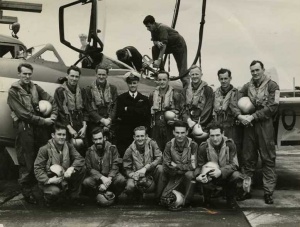
At around the same time, fatigue cracks had been discovered in the wing structure of some Sea Venoms in the UK. While this was unrelated to the accident that had claimed the lives of Lieutenants Thompson and Potts, 808 Squadron was grounded at Jervis Bay until the aircraft and the crash could be investigated. Five Australian Sea Venoms were found to have fatigue cracks but 808 Squadron re-embarked aboard Melbourne by the end of August with ten aircraft.
Melbourne took part in South East Asia Treaty Organisation (SEATO) exercises visiting Singapore, Hong Kong and Manila before returning to Australia to assist with the 1956 Olympic Games. A problem with Melbourne's steam catapult limited 808 Squadron's operations during this period but it still developed a strong reputation as an effective fighter unit.
808 Squadron was decommissioned at Nowra on 1 December 1958.
With the arrival of the new Australian Aerospace MRH-90 Taipan multi-role helicopter, 808 Squadron was recommissioned at HMAS Albatross on 11 July 2013.
The squadron’s recommissioning marked the culmination of three years of training, testing, development and trials of the new MRH-90 Taipan multi-role helicopter which replaced the retired Sea Kings. HMA Ships Choules, Success (II) and Tobruk (II) currently operate the MRH-90 as will the new Canberra Class amphibious ships, Canberra (III) and Adelaide (III) when they commission in the near future.
In July-August 2013 two separate Taipan flights from 808 Squadron were operating at sea. Flight One, embarked in HMAS Choules, participated in Exercises SEA LION and TALISMAN SABRE while Flight Two, embarked in Tobruk, took part in PACIFIC PARTNERSHIP 2013 off Papua New Guinea. In November 808 Squadron Taipans were sent to RAAF Base Richmond from where they flew missions in support of Operation NSW BUSHFIRE ASSIST.
On 18 November 2013 a Taipan flight was assigned at short notice to embark in Tobruk for Operation PHILIPPINES ASSIST, the ADF’s relief mission to the Philippines in the wake of Cyclone Haiyan. With four pilots and four aircrewmen under the command of Lieutenant Commander Greg Davison, RAN, the flight conducted personnel and supply transfers as well as medical evacuation.
Chronology of 808 Squadron history
|
Date
|
Event
|
| 01 Jul 1940 | Formed as a RN Fleet Fighter Squadron |
| 05 Dec 1945 | Disbanded |
| 25 Apr 1950 | Commissioned at St Merryn, UK with Hawker Sea Furies for service in HMAS Sydney as part of 21st Carrier Air Group |
| 31 Aug 1951 | Departs Australia for Korean War |
| 11 Oct 1951 | Sets light fleet carrier record by flying 89 sorties in one day |
| 27 Jan 1952 | Tour in Korea ends |
| 14 Oct 1952 | Four 808 Squadron aircraft make history by landing aboard HMAS Sydney while the ship is at anchor |
| 05 Oct 1954 | Squadron decommissioned |
| 23 Aug 1955 | Squadron recommissioned at Yeovilton, UK with de Havilland Sea Venoms for service in HMAS Melbourne |
| 01 Dec 1958 | Squadron decommissioned |
| 11 Jul 2013 | Squadron recommissioned |
Commanding Officers of 808 Squadron
|
Assumed Command
|
Commanding Officer
|
| 25 Apr 1950 | Lieutenant Commander JL Appleby, RN |
| 02 Jun 1952 | Lieutenant GFS Brown, DFC, RAN |
| 20 Jul 1952 | Lieutenant Commander JHG Cavanagh, RAN |
| 18 May 1953 | Lieutenant Commander CA Beange, DSC, RAN |
| 27 Sep 1954 | Lieutenant AG Powell, RAN |
| 05 Oct 1954 | Decommissioned at HMAS Albatross, RANAS Nowra |
| 18 Feb 1955 | Formed as 'X' Flight of 891 Squadron Royal Navy at HMS Heron, RNAS Yeovilton, Somerset, England |
| 10 Aug 1955 | Lieutenant Commander G McC Jude, RAN |
| 04 Nov 1956 | Lieutenant Commander PW Seed, RAN |
| 10 Jan 1957 | Lieutenant Commander AG Cordell, RAN |
| 05 Aug 1957 | Lieutenant Commander G Kable, RAN |
| 07 Mar 1958 | Lieutenant Commander GJG Hanchard-Goodwin, RN |
| 01 Dec 1958 | Decommissioned at HMAS Albatross, RANAS Nowra |
| 03 Dec 2010 | Commander TP Leonard, RAN (Formed as NUSQN 808 at HMAS Albatross) |
| 04 Nov 2011 | Commander CRL Stephenson, RAN |
| 20 Jan 2014 | Commander AJ Capner, RAN |
| 16 Jan 2016 | Commander WA Waddell, RAN |
| 15 Dec 2017 | Commander S Palmer, RAN |
| 09 Dec 2019 | Commander PF Hannigan, RAN |
Battle Honours
Further reading
- 'Flying Squadrons of the Australian Defence Force', Steve Eather, Aerospace Publications, Canberra, 1995.
- 'Wings Across the Sea', Ross Gillett, Aerospace Publications, Canberra, 1988.
- 'Wings and the Navy 1947-1953', Colin Jones, Kangaroo Press, Kenthurst, 1997.
- 'Flying Stations: A Story of Australian Naval Aviation', Australian Naval Aviation Museum, Allen & Unwin, St Leonards, 1998.

